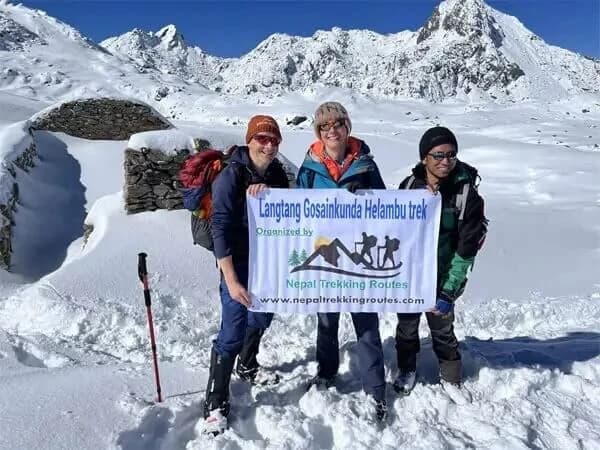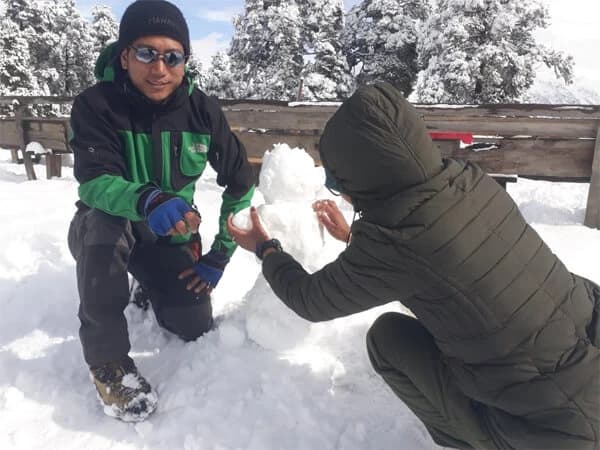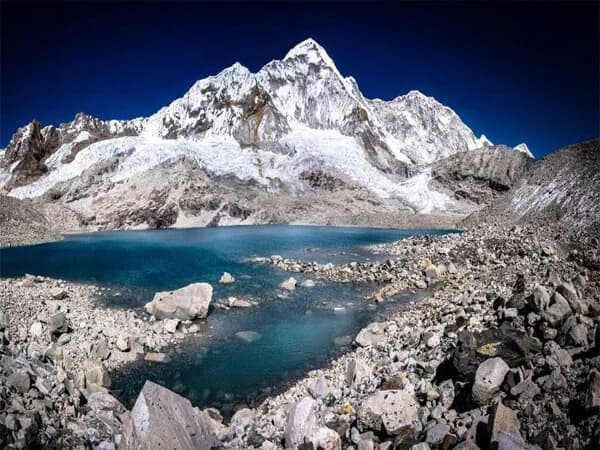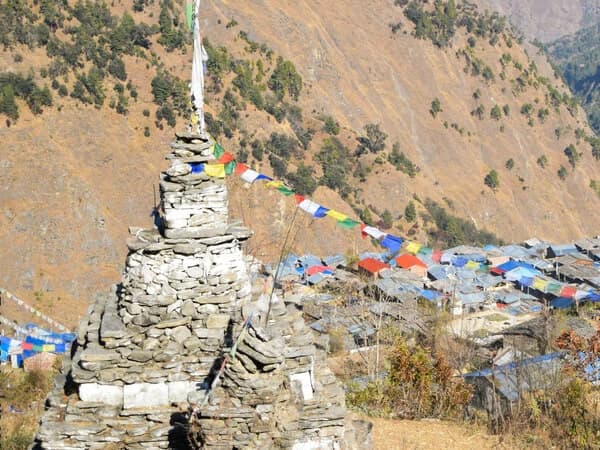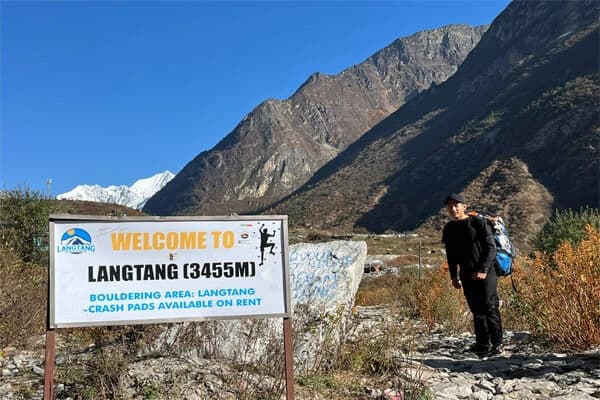Before deciding to book the trip, you might wonder “How difficult is Langtang Valley Trek?” Langtang Trek difficulty can be beaten even by beginner trekkers because it is a moderate type of trekking in Nepal.
Among the protected areas, Langtang National Park is the second popular trekking destination of Nepal. Langtang Valley Trek can be combined with Gosainkunda Trek and Helambu Trek as well.
Langtang Valley Trek is famous for its natural beauty and cultural uniqueness. Tamang Heritage Trail Treklets you be more familiar with their typical lifestyle, culture, and tradition.
The biodiversity of Langtang Valley makes your trek more interesting and a lifelong memory. The Himalayan plants and animals including butterflies are the assets of this region.
The snowcapped peaks of Nepal such as Langtang Lirung (7,234m), Langtang Ri (7,205m), Dorje Lakpa (6,988m), Ganesh Himal (7,422m), Mt. Shishapangma (8,027m), etc. are seen during this trek.
The rewards you get from the trip outweigh Langtang Trek difficulty. To assess the difficulty level of Langtang Valley Trek, we must consider the most responsible factors of trek in Nepal. Let’s take a look at every such factor in this Langtang Trek difficulty blog.
What are the Langtang Valley Trek Difficulty?
The Langtang Valley trek difficulty level is considered moderate for both beginners with basic physical capabilities and seasoned trekkers. The trail has some steep parts, particularly close to Kyanjin Gompa and Kyanjin Ri, as well as river crossings and gentle uphill and downhill hikes. If you climb too quickly, altitude sickness may become an issue because the highest elevation is approximately 4,984 meters. However, the Langtang Valley trek's difficulty level is achievable because of its well-marked pathways and shorter walking hours than other high Himalayan climbs. For the majority of trekkers, this journey is safe and enjoyable with adequate acclimatization, comfortable pacing, and basic planning.
Altitude Gain and Terrain
Langtang Valley Trek formally begins from Syabru Besi at 1,550m and gradually ascends towards higher altitude. The maximum Langtang trek elevation gain is 3,870m (Kyanjin Gompa).
Hiking to Tserko Ri (5,000m) is optional that most of the Langtang Valley trekkers do on Kyanjin Gompa acclimatization day. Otherwise, from Syabru Besi, the Langtang Valley trekking trail reaches about 800m, then, 1,100m, and 400m higher respectively.
Langtang Valley terrain ranges from 1,550m to 3,870m. The terrain elevations gradually rise until you reach Kyanjin Gompa. Then, during the descent to Syabru Besi, the terrain level gradually decreases. As the Langtang trek elevation gain is gradual, Langtang Valley Trek difficulty can be beaten by beginner trekkers as well.
AMS or Altitude Sickness
To know about Langtang Trek difficulty, let’s take a quick look at AMS or altitude sickness. In the beginning of the trek, even beginner trekkers don’t have to worry about the acute mountain sickness (AMS) or altitude sickness.
But when you ascend towards Mundu from Lama Hotel, the trail elevation rises higher than 3,000m. As soon as you reach higher than 2,500m, there is always possibility of AMS or altitude sickness. However, if followed some preventive measures, you can easily overcome AMS or altitude sickness.
Weather Conditions
We should also discuss about Weather impact on Langtang trek difficulty. Weather conditions play a significant role in making trekking in Nepal a success or failure.
Like other trekking destinations, Langtang Region also experiences different weather conditions in four different seasons. Langtang Valley Trek can be done throughout the year due to its low altitude and close proximity from the Kathmandu Valley.
The best seasons for trekking in Nepal are spring (March – May) and autumn (September – November). Trekking to Langtang Valley in spring and autumn facilitates you with the appealing mountain scenery and attractive landscapes.
In the best seasons for Langtang Trek Difficulty, the days are fine with clear skies that serve eye-catching vistas of snowcapped peaks of Nepal and Tibetan Plateau as well. Additionally, Langtang Trek in spring is the best time to observe the entire region wrapped up in full blossoms.
Forests of oak, silver fir, hemlock, larch, maple trees are beautifully covered with their colorful flowers. Various species of rhododendron flowers make the national park not less attractive than a bride on her wedding day.
On the other hand, summer (June – August) and winter (December – February) are off seasons of trekking in Nepal. Langtang trekking in summer might be more difficult due to rainfall and slippery trails.
Likewise in winter season, the temperature falls far below than average resulting into freezing cold. Due to the less favorable weather conditions, snowcapped peaks and surrounding areas might not be seen clearly. Sometimes, leeches and bugs can further increase difficulty for Langtang valley trek in summer and winter.
Langtang Trekking Route Challenges
Although the Langtang Valley hiking is moderately challenging, there are several obstacles to overcome. Beginning in Syabrubesi, the trip progressively ascends alongside the Langtang River through woods, suspension bridges, and winding trails. Despite having clear signage, the trek requires five to seven hours of walking each day, which can be taxing for novices. There are difficult climbs in several places, particularly before you get to the Lama Hotel and Kyanjin Gompa. Some sections of the trail may be rocky and damaged due to the destruction of infrastructure during the 2015 earthquake.
The lack of medical services along the route presents another difficulty. Trekkers must be emotionally and physically equipped to handle cold weather, exhaustion, and mild medical conditions. Technical abilities like climbing or utilizing ropes are not necessary for the walk, but it is crucial to keep a steady pace, drink plenty of water, and get enough sleep. For first-time hikers in particular, hiring a local guide or porter can help manage these difficulties. Though they should not be undervalued, the route problems are generally achievable with preparedness.
Langtang Trek Altitude and Acclimatization
Altitude is a major determinant of the Langtang Valley trekking difficulty. Starting at about 1,400 meters at Syabrubesi, the hike progressively ascends to Kyanjin Gompa at 3,870 meters. The elevation can rise to 4,984 meters if hikers decide to continue on to Kyanjin Ri or Tserko Ri. Because the air is thinner at this level, altitude sickness is more likely to occur. Headaches, tiredness, nausea, and dizziness are typical symptoms.
In order to ensure safety, proper acclimatization is crucial. Before tackling higher vistas, trekkers are encouraged to acclimate for an additional day at Kyanjin Gompa. The body adjusts to high altitude better when you walk slowly, drink lots of water, and abstain from alcohol. It is also critical to pay attention to your health; if symptoms worsen, the best course of action is to descend right away.
The height climb in Langtang is more gradual than in other high Himalayan hikes, such as the Annapurna Circuit or Everest Base Camp. This facilitates acclimation, particularly for trekkers who are new to the area. However, a safe trekking experience requires planning, understanding altitude sickness, and having a flexible schedule.
Langtang Valley Trail Conditions
The Langtang Valley trekking trail conditions range from rough uphill climbs to easy forest trails. The trail winds through thick rhododendron, pine, and bamboo forests in the lower elevations. Even though these areas are usually smooth, rain or snow can make them slick, particularly in the winter or monsoon season. The route opens out as trekkers ascend toward Ghodatabela and Langtang Village, traversing landslide zones and uneven terrain.
Although a large portion of the route was restored following the 2015 earthquake, there are still minor landslides and loose stones to be seen. Steep stone steps and suspension bridges are typical, especially in the area around Jhapche and the Lama Hotel. Snow can cover the trail in the winter, making it more difficult to follow without a guide. The track is usually well-maintained and safe throughout the busiest trekking seasons, such as spring and fall.
Along the route, teahouses provide lodging, food, and rest, which facilitates the trip. Trekkers should, however, bring appropriate footwear, walking poles, and rain gear. Although generally manageable, the Langtang Valley trek requires caution, particularly in bad weather or high-altitude areas.
Physical Fitness and Mental Readiness for Langtang Trekking
Your physical fitness and mental readiness also plays a vital role in coping with Langtang Trek difficulty. Yes, Langtang Trek doesn’t require any previous experience of trekking in Nepal. Nevertheless, if your Fitness level for Langtang Valley trek is perfect, you can do this trip without any worries.
And obviously, your physical fitness and training including daily warm up activities shape your mental readiness. When you are physically fit and mentally ready, you can easily deal with the difficulty level of Langtang Valley Trek.
Langtang Valley Trekking Hours per Day
Langtang Valley Trekking hours per day also contributes in measuring Langtang Trek difficulty. Langtang Valley Trek contains 5 days trekking and 1 acclimatization day.
For 4 days, you have to walk 7/8 hours along the steep and sloppy trails. To reach Kyanjin Gompa from Mundu, you should walk 3/4 hours. Kyanjin Gompa (3,870m) is the highest point of Langtang Valley Trek. Therefore, the trekking hour is the shortest of the trip.
On Kyanjin Gompa acclimatization day, you might love hiking to Tserko Ri (5,000m) as well. For Tserko Ri hiking, you have to ascend and descend for about 5/6 hours. You might require longer time as well because of the trail condition and altitude gain.
Langtang trek distance and walking hours
The Langtang valley trekking distance and walking hours make it one of the most rewarding yet accessible moderate treks in Nepal Himalayas. The average length of the entire journey from Syabrubesi to Kyanjin Gompa and back is 65–70 kilometers (40–45 miles). Trekkers usually walk for five to seven hours every day, depending on the weather, pace, and level of fitness. To get to the Lama Hotel and Langtang Village over the first few days, one must travel along riverbank paths and through lush forests. Although somewhat steep, most hikers can handle these parts.
The trail gradually gains elevation from Langtang Village to Kyanjin Gompa, becoming more open. For acclimatization and optional climbs to Kyanjin Ri or Tserko Ri, which can take four to seven hours round trip, most hikers stay an additional day at Kyanjin Gompa. Despite the moderate daily walking hours, there is some difficulty due to the high altitude and hilly paths.
The Langtang trekking is ideal for those looking for moderate treks in the Nepal Himalayas that offer stunning scenery, Sherpa culture, and manageable walking hours without requiring advanced trekking experience because it is shorter in distance and duration than longer expeditions like Everest Base Camp or Annapurna Circuit.
Availability of Food and Accommodation Services During the Langtang Valley Trek
Langtang Trek difficulty should be analyzed from the perspective of food and accommodation availability. Langtang Valley trek is completely teahouse trekking in Nepal. Thus, you don’t have to worry about food and accommodation services during the trip.
However, in peak seasons, i.e. spring and autumn, the teahouses en route Langtang Valley Trek might be full. Therefore, informing the teahouse owners in advance is the best option to get the food and accommodation facilities.
Remember that you might not get the quality of food and accommodation services as in the urban areas of Nepal. Arrangement of food and accommodation services if the responsibility of the local tour operator you book the trip with. Therefore, stay out of any worry about it!
Langtang Valley Trek Itinerary
Langtang Valley Trek itinerary ranges from 8 days to 17 days depending upon your choice and desire. For Langtang Gosainkunda Helambu trek, you need 17 days long itinerary.
But if you want to explore Langtang Valley or do Tamang Heritage Trek, only 8 days is enough.
Outline Itinerary:
- Day 01: Drive from Kathmandu (1,350m) to Syabru Besi (1,550m) – 7/8 Hrs
- Day 02: Trek to Lama Hotel (2,380m) – 6/7 Hrs
- Day 03: Trek to Mundu (3,430m) via Langtang Village (3,400m) – 6/7 Hrs
- Day 04: Trek to Kyanjin Gompa (3,870m) – 3/4 Hrs
- Day 05: Hike to Tserko Ri (5,000m) – 5/6 Hrs
- Day 06: Trek back to Lama Hotel (2,380m) – 6/7 Hrs
- Day 07: Trek to Syabru Besi (1,550m) – 6/7 Hrs
- Day 08: Drive back to Kathmandu (1,350m) – 7/8 Hrs
How to minimize Langtang Valley Trek difficulty?
Langtang Valley Trek has moderate type difficulty level. Moreover, it demands no previous experience of peak climbing and trekking in Nepal. However, as a beginner trekker, you might find Langtang Trek difficulty quite challenging. To overcome difficulty level of Langtang Valley Trek, we recommend you the following:
- Do some warm up activities like day hikes, swimming, regular exercise, etc. This will increase your physical stamina.
- Wear comfortable shoes and clothes including using proper suitable trekking gear.
- Have enough sleep, drinkable water, hygienic food, and rest in the middle of the trekking trail.
- Keep some altitude sickness preventive and curative medicines in your backpack.
- If any AMS symptoms, share with your trekking guide.
- To avoid threats from wildlife, follow the right trail recommended by your team leader.
Langtang Valley Trek experience
Trekking through one of Nepal’s most beautiful Himalayan regions, Langtang Valley, is an incredible experience. The journey is well-known for its breathtaking scenery, vibrant Tamang culture, and accessible yet challenging trails.
The trek begins with a lengthy but scenic drive from Kathmandu to Syabrubesi. Syabrubesi is the trek’s beginning point. From there, the trail follows the Langtang river through thick forests with bamboo and rhododendrons. As you ascend, the landscape transforms from lush greenery to rugged alpine terrain. You can also see the snow-capped peaks rising above.
One of the highlights is visiting the Langtang Village, which had been restored after the 2015 earthquake. It is inspiring to see the friendly and resilient villagers. Further up, Kyanjin Gompa feels like entering a dream, surrounded by majestic mountains such as Langtang Lirung. Hiking to Kyanjin Ri before sunrise, provides one of the most breathtaking panoramic views.
The trek is rewarding despite being difficult. The hospitality of the Tamang people, simple food and the peaceful atmosphere of the Himalayas make this trek an unforgettable experience. Langtang Valley trek is truly a hidden gem for trekkers looking for adventure and cultural immersion.
Langtang trek compared to Annapurna or Everest
Difficulty and Trekking Experience
As a moderate trek, Langtang is a little easier than Everest Base Camp (EBC) and comparable to the Annapurna Base Camp (ABC) trek. Langtang's highest peak is approximately 4,984 meters (Kyanjin Ri), whereas EBC reaches high altitudes of 5,364 meters and necessitates additional trekking days. Long walking hours and steep stone staircases are also features of Annapurna treks, although Langtang offers a more relaxed pace with fewer people and shorter trekking distances. Trekkers frequently choose Langtang because it offers the Himalayan splendor without posing significant physical hurdles.
Altitude and Acclimatization
Since trekkers spend many days above 4,000 meters, altitude is a significant challenge on the Everest expedition. Although the Annapurna Circuit is Thorong La Pass (5,416m) is one of Nepal's highest trekking destinations, the Annapurna's elevation climb is modest. By contrast, the altitude in the Langtang Valley is tolerable, and Kyanjin Gompa offers opportunity for natural acclimatization. Although there is still a chance of altitude sickness, it is less common than on Everest and Annapurna.
Scenery and Cultural Experience
The Everest region is well-known for its busy paths, Sherpa culture, and stunning vistas of Mount Everest. Terraced farms, rivers, and breathtaking mountain views like Machapuchare and Annapurna I are just a few of the varied landscapes found in Annapurna. Langtang, meanwhile, blends Tibetan-influenced Tamang culture with glaciers, yak farms, and alpine meadows. Trekkers can have a more intimate and genuine local experience because it is more serene and tranquil than the crowded Everest and Annapurna routes.
Accessibility and Duration
The easiest to get to is Langtang, which is only a 6–7 hour journey from Kathmandu. While Annapurna often begins with a lengthy drive or flight to Pokhara, Everest necessitates a flight to Lukla. While Everest and Annapurna often take 12 to 15 days to conquer, Langtang can be finished in 7 to 9 days.
Safety and Guide Support on Langtang Trek
Given that the Langtang trek winds through high-altitude regions, woods, and isolated communities, safety is crucial. Even though the route is well-marked and regarded as moderate, trekkers may still encounter difficulties such as landslide-prone routes, altitude sickness, shifting weather patterns, or a lack of medical facilities. Some settlements have mobile networks, however higher elevations could not have any signal, making it challenging to stay connected. For safety, it is crucial to have a first aid kit, warm clothes, and appropriate trekking equipment with you.
Having a certified trekking guide by your side increases security. Guides receive training in local navigation, altitude sickness prevention, and first aid. They assist in setting up safe walking routes, lodging, and meals. Guides can help with rescue operations and communication in an emergency. By carrying your backpack, hiring a porter also eases your physical strain and lets you walk more pleasantly.
Although it is permitted, solo trekking is not generally advised for novice trekkers. In addition to ensuring your safety, a guide may assist you comprehend the customs, monasteries, and Tamang culture of the area. The Langtang trek can be a stress-free, safe, and pleasurable Himalayan trip with careful preparation, the assistance of local guides, and a moderate pace.
Langtang trek for beginners
The Langtang trek for beginners is a great option because it provides a stunning view of the Himalayas without being very strenuous or drawn out. Walking five to six hours a day on clearly indicated pathways, the expedition often lasts seven to nine days. The journey begins with a drive from Kathmandu to Syabrubesi and then progressively ascends via villages, rivers, and woods to reach Kyanjin Gompa. Despite the mild difficulty of the trek, novices should equip themselves with appropriate trekking footwear, warm clothing, and a basic level of fitness.
Because altitude might be difficult, it is crucial to walk slowly and take days off to acclimate. It is safer and easier to travel with a native guide or porter. All things considered, Langtang is among Nepal's top hikes for novices.
Langtang Valley Trek Preparation Tips
1. Improve Fitness
- Start light exercises like walking, jogging, cycling, or hiking 4–6 weeks before the trek.
- Focus on leg strength and stamina to handle 5–7 hours of daily walking.
2. Pack the Right Gear
- Carry warm layers, waterproof jacket, trekking shoes, gloves, hat, and thermal wear.
- Don’t forget sunglasses, sunscreen, reusable water bottle, and a sleeping bag rated for cold weather.
3. Plan for Altitude
- The trek reaches above 3,800m, so walk slowly and take an acclimatization day in Kyanjin Gompa.
- Drink plenty of water and avoid alcohol or smoking.
4. Hire a Guide or Porter
- A local guide helps with navigation, culture, and safety.
- A porter can carry heavy bags, helping you conserve energy.
5. Obtain Necessary Permits
- Carry TIMS Card and Langtang National Park Permit.
- Keep passport copies and passport-sized photos.
6. Pack a Basic First Aid Kit
- Include medicines for headaches, fever, altitude sickness Medicine, bandages, and antiseptic.
7. Mental Preparation
- Be ready for basic accommodation, cold weather, and no Wi-Fi in higher regions.
Conclusion: Langtang valley trek
Even beginner trekkers without any previous experience of trekking in Nepal can easily beat Langtang Trek difficulty. The difficulty level of Langtang Valley Trek is put under the moderate type because of its proximity and trail conditions including elevation gain.
Moreover, the weather conditions, food and accommodation services, it is one of the most popular treks in Nepal.


